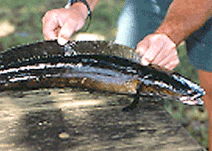Michael Fumento
Factual · Powerful · Original · Iconoclastic
Snakehead in the Bathtub
September 13, 2002 · Michael Fumento · Tech Central Station · BiotechA few years ago everybody’s favorite technophobe, Jeremy Rifkin, coined the term "genetic pollution." He believed it was "going to gain currency very quickly." It didn’t. But it may get a boost from a recent study by a National Academy of Sciences committee warning that genetically engineered animals may pose serious risks to the environment. Indeed, the escape of such animals into the wild could alter species or even wipe them out, it said.
The report wasn’t anti-biotech, per se. It noted many potential benefits of animal biotechnology such as new drugs and medical treatments and cheaper, healthier food. But how real is the worry over escaped bio-engineered animals – or other organisms for that matter?
In the broadest sense, it’s quite real because it’s completely natural. Nature creates new plants from old, while others become extinct. Animals on the verge of extinction may suddenly proliferate and destroy their competitors. No creature is too mighty to be exempt from this cruel reality, as any dinosaur will gladly relate.

These Aqua Bounty salmon are what biotech bashers call "Frankenfish" . . .
Ask experts to name one notorious plant, animal, and insect pest and probably near the top of each list would be kudzu, rats, and Africanized or "killer" bees. None are native to North America.
The kudzu vine came to the U.S. in 1876 as a gift of the Japanese government. During the Great Depression the Soil Conservation Service promoted planting of the vine, which grows as much as 60 feet a year a year, for erosion control. Now it covers 7 million acres of the South, destroying any plant that dares grow in its path. Herbicides must be applied to kudzu at least four straight years to kill it.
The rodent that plagues U.S. inner cities and farms, the "Norway rat," probably originated in Central Asia. (It has no particular connection to Norway, but you’ve got to blame somebody.) It’s widely thought the rats immigrated to the U.S. aboard the ships of Hessian mercenaries. Consider them revenge for Valley Forge.
The tale of the Africanized bee is the most appropriate here because it shows the dangers of old-fashioned cross-breeding. Brazilian honey farmers wanted an insect with the hardiness of the African bee and the productivity of the European honey bee. Instead, they got super-aggressive bees that produced virtually no honey. As they say in Brazil: "Oops!" The insects then began a trek north that has resulted in dozens of dead people each year and – almost as bad – a spate of terrible "killer bee" movies.
Looking at a selection of just 79 harmful species, one federal study found they cost a cumulative total of $96 billion over the last century. A 1998 article in Bioscience put the figure of bio-invader damage plus control at $136 billion a year. Yet every penny is spent on so-called "natural" species, not biotech ones.
Genetically engineered organisms have an inherent advantage in that biotechnology allows the selective transfer of a single gene or set of genes for a specific trait. If the sought-after trait is expressed, eureka! If it’s not, the experiment ends.
Nevertheless, many environmentalists are apoplectic over the plans of the U.S. and Canadian company Aqua Bounty Farms to begin farming salmon that were genetically engineered to grow more quickly – and hence more cheaply – to market size. Naturally, they’ve dubbed them "Frankenfish."
Never mind that the engineered salmon are sterilized so that even if they escaped they couldn’t threaten wild Atlantic salmon populations, nor that there’s nothing about making a fish grow faster that would give it an eating or breeding advantage over conventional salmon.

. . . while this snakehead monstrosity is okey-doke because it’s 100% natural.
If it’s a real Frankenfish you want, look no further than the beast Mother Nature conjured up that was discovered recently in a Maryland drainage pond. Early reports of a huge creature with a snake-like head and razor-sharp teeth were treated as just another fish tale – until one was caught. And then more. They proved to be natives of Asia, called the northern snakehead, which somebody had tossed into the water.
The monsters grow to be three feet long and as an Interior Department spokesman told a reporter, "They eat literally anything that’s living," including ducklings. Soon nothing is left but the snakeheads.
Oh, but it gets worse. The snakehead has no trouble surviving cold winters and it has one especially hideous trick up its fin. By virtue of a primitive lung, it can crawl out of the water and wriggle across dry land until it finds another home. It – and its offspring – can then eat their way through that and, as product instructions often say, "repeat process as necessary."
All of this is something to think about the next time you hear wailing and the gnashing of teeth over the mere possibility that a transgenic organism might escape from a lab or outdoor test area and harm the eco-system.
Certainly we don’t want biotech to repeat the mistakes of the past. Selective gene transfer will help prevent that. So will the strict regulations that are applied only to transgenic organisms. But talk about "genetic pollution" is psychobabble. It sounds spooky, but hardly compares to finding a snakehead in your bathtub.
